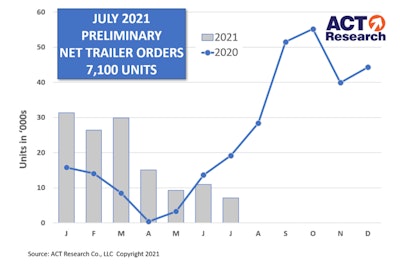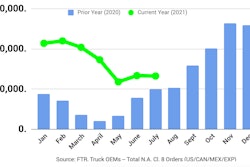
Preliminary trailer order totals continue to slide, registering only 8,200 units in July, 32 percent below June and down 58 percent year over year. Trailers orders for the past 12 months now total 354,000, FTR reports.
ACT Research’s preliminary reports show trailer OEMs posted 7,100 net orders in July, roughly two-thirds of June’s volume and 63 percent less than the same month last year, according to ACT Research’s State of the Industry: U.S. Trailers report.
Dry and refrigerated van orders remained paltry, as OEMs are booked full for 2021 and not entering orders yet for 2022. Vocational orders fell as well in July, as fleets have most of their orders in for this year, FTR reports.
“The orders are in for 2021 but the challenge remains to build the trailers. OEMs continue to struggle hiring factory workers. Suppliers are struggling to keep pace due to a shortage of manpower and imported parts and components. The supply chain is still experiencing disruptions and bottlenecks. Some improvement in production is expected this year, but there are indications some supplies will be restricted into next year,” says Don Ake, FTR vice president of commercial vehicles.
“Fleets are desperate for new dry vans to compensate for the shortage of new trucks and drivers in the current tight capacity environment,” Ake says. “There is a growing amount of freight to be moved and the industry continues to struggle to deliver it on time. Spot loads and rates remain elevated. The semiconductor shortage is limiting Class 8 production and the driver shortage has been exacerbated by the aftereffects of the pandemic.”
Frank Maly, ACT director CV transportation analysis and research, says trailer orders remained low for the fourth consecutive month in July.
“The issue is certainly not demand related, as fleets remain bullish regarding equipment acquisition. With existing orderboards stretching through the end of 1Q2022 on average and well into 2Q2022 for dry vans and reefers, OEMs continue to limit order acceptance,” Maly says. “OEMs’ concerns regarding their supply chain, staffing availability and pricing of components and materials are mainly responsible for the continued reluctance to accept further orders in the near-term. However, when the order season eventually opens, expect a surge of pent-up volume to flood in, likely resulting in a very significant commitment of available 2022 production capacity.”
Maly commented further on production capacity and levels. “Initial reports indicate that OEMs were unable to increase daily production rates in July, as supply chain and staffing headwinds continue to challenge ramp-up efforts in response to their solid orderboards. While some announcements point to additional industry capacity coming online, those continuing component and staffing issues could make it challenging to fully utilize that potential in the near-term.”











